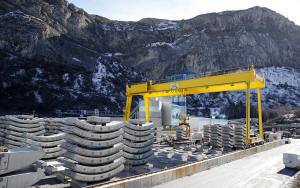How 4 key infrastructure projects centered in Italy will reshape the
European travel map
[September 18, 2025] By
COLLEEN BARRY
MILAN (AP) — Workers will begin drilling and blasting open the first
tunnel connecting Austria to Italy under the Brenner Pass through the
Alps on Thursday, marking a major milestone in a series of ambitious
European Union projects that will accelerate passenger train travel
between metropolitan centers and shift freight off the roads and onto
rails.
The Brenner Base Tunnel, which is being billed as the longest
underground rail tunnel in the world when completed, is among four key
infrastructure projects that promise to reshape how Italians travel and
ship goods by the early 2030s.
Tunnels will cut travel times between Verona and Munich by 40% to three
hours, between Milan and Paris by at least 30% to 4˝ hours and put the
Ligurian port city of Genoa within commuting distance of Italy’s finance
and fashion capital — significantly remaking the Europe transit map.
The boldest and most contested projects of them all, the recently
approved Straits of Messina Bridge, will finally link the Italian
mainland with Sicily — a project first envisioned by the ancient Romans
and long delayed by modern Italians.
The tunnels and bridge will mark the first significant upgrade to the
Italian rail system since the Rome-Milan high-speed rail line was
launched in 2008. It drastically reduced travel time between Italy’s
financial and political centers, effectively killing the once-lucrative
Rome-Milan airline route. The rail line can now be traveled in as little
as three hours.

The current projects also aim to reduce truck traffic on highways — with
the biggest impact expected on the Brenner Pass, which is traversed by
more than 2.5 million trucks annually, making it one of Europe’s busiest
Alpine routes and a crucial north-south link, bringing Italian
automotive components and small machinery northward. The Brenner Base
Tunnel aims to shift up to half the heavy road traffic to rail.
While pursuing these major projects, Italy's rail network has another 40
strategic projects in the works, many funded with 25 billion euros
(nearly $30 billion) in European Union pandemic recovery funds. They
include a high-speed line between Naples and Bari on the heel of the
Italian boot.
These are the four major infrastructure projects:
Brenner Base tunnel
The Brenner Base tunnel, which will be the longest underground rail
tunnel in the world, will run for 55 kilometers (34 miles) between
Tulfes, Austria, and Fortezza, Italy, extending to 64 kilometers (nearly
40 miles) with existing tunnels from Tulfes to Innsbruck.
The project, which is estimated to cost about 8.8 billion euros (nearly
$10.5 billion), is expected to be completed by 2031 with the first train
traversing it in 2032. The project, launched in 2014, is being co-funded
by Italy, Austria and the EU.
[to top of second column] |

Parts of the a tunnel being built on the Turin-Lyon high-speed rail
link (TAV) are piled up in Saint Martin La Porte, France, Feb. 12,
2019. (AP Photo/Antonio Calanni, File)
 Tortona-Genoa high-speed rail
line
A 53-kilometer (33-mile) high-speed rail line connecting the port
city of Genoa with Tortona in Piedmont, with links to Milan,
includes 37 kilometers (23 kilometers) of tunnels.
One of them is 27 kilometers (more than 16˝ miles) long. It aims to
shift the transport of goods from the Ligurian port cities of Genoa,
La Spezia and Savona to northern Europe from road to rail beginning
next year, increasing to 50% by 2050.
Passenger train travel time between Milan and Genoa will be cut to
about an hour from more than 1˝ hours. The cost is 8.5 billion euros
($10 billion) and the tunnels are 90% complete. Started in 2012, the
project was slowed by the difficult geology of the Apennine range,
including the discovery of natural asbestos.
Lyon-Turin line
The 11-billion-euro ($13 billion) Lyon-Turin High-Speed Rail Tunnel
extends more than 65 kilometers (40 miles) with 57˝ kilometers
(nearly 36 miles) of the Mont Cenis base tunnel running underground
from Saint-Jean-de-Maurienne, France and Susa, Italy.
It's expected to be completed around 2033. The project aims to
remove more than 1 million heavy goods vehicles from roads in the
western Alps between France and Italy. Passenger travel time between
Paris, Europe’s second-largest metropolitan area, and Milan,
Europe’s third-largest metropolitan area, will be reduced to 4˝
hours from 6˝-7˝ hours.
The project, launched in 2007, was slowed significantly by
environmental protests on the Italian side. It's being co-funded by
France, Italy and the EU.
Strait of Messina Bridge
The 13.5 billion-euro ($16 billion) Strait of Messina Bridge project
will speed travel between the Italian mainland and Sicily and
incorporate rail connections to Palermo and Catania, which are being
upgraded.
The single-span bridge itself will span from Messina, Sicily, to
Villa San Giovanni, Calabria, with six car lanes and two rail lines.
The government is awaiting final approval by the court of audits to
launch preliminary work. It's expected to be completed by 2032.
All contents © copyright 2025 Associated Press. All rights reserved
 |